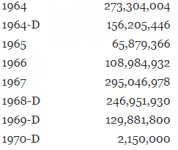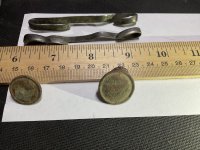blueberra
Full Member
The good news : this week's box contained 11 40% silver halves.
My question : in the year I have been CRHing (at about 1 box of halves per week), I have found 88 40% silver halves; however, none has been a 1965.
According to my math, approximately 7.78% of the 'minted for circulation' 40% silver halves (excluding 1970D and bicentennial 'S' 40%) were 1965, so the chances of my not finding a 1965 in 88 attempts is (1-0.0778)^88 = 0.9222^88 = approximately 0.08% (one in 1246) -- a very small percentage, indeed.
I assume all 40% 'minted for circulation' dated halves have an equal likelihood of being culled from boxes / tellers / etc., so am I just 'unlucky' or am I missing something?
It's not like I'm looking to assemble a date set of Kennedys, but the other dates seem pretty much in line with the mintages -- just the 1965 is the outlier.
My question : in the year I have been CRHing (at about 1 box of halves per week), I have found 88 40% silver halves; however, none has been a 1965.
According to my math, approximately 7.78% of the 'minted for circulation' 40% silver halves (excluding 1970D and bicentennial 'S' 40%) were 1965, so the chances of my not finding a 1965 in 88 attempts is (1-0.0778)^88 = 0.9222^88 = approximately 0.08% (one in 1246) -- a very small percentage, indeed.
I assume all 40% 'minted for circulation' dated halves have an equal likelihood of being culled from boxes / tellers / etc., so am I just 'unlucky' or am I missing something?
It's not like I'm looking to assemble a date set of Kennedys, but the other dates seem pretty much in line with the mintages -- just the 1965 is the outlier.
Amazon Forum Fav 👍
Upvote
0






